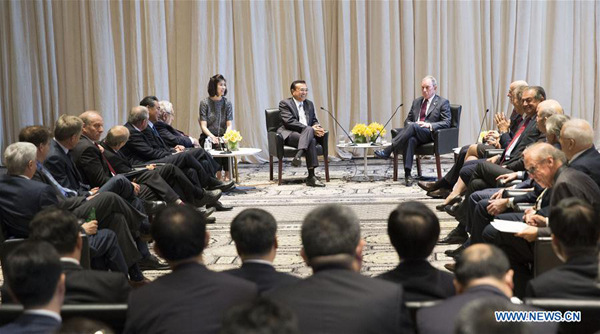
Chinese Premier Li Keqiang (C Back) meets with a group of leading figures in the U.S. financial, think-tank and media circles to discuss bilateral ties and issues of common concern in New York Sept. 20, 2016. (Photo: Xinhua/Huang Jingwen)
Chinese Premier Li Keqiang met in New York on Tuesday with over a dozen of prominent figures from U.S. economic, financial, academic and media circles at Waldorf Astoria and answered questions regarding China-U.S. relations and other issues of common interest.[Special coverage]
Among those present were: former Mayor of New York City and founder of Bloomberg LP Michael Bloomberg, former Secretary of State Dr. Henry Kissinger, former Secretary of the U.S. Treasury Henry Paulson, IBM Chair and CEO Ginni Rometty, Chairman and CEO of the Blackstone Group Steve Schwarzman, Chairman and CEO of Dow Chemical Company Andrew Liveris, President and CEO of MetLife Steven Kandarian, President of the Council on Foreign Relations Richard Haass, and PBS anchor Charlie Rose.
The following is a transcript of Premier Li' s remarks at the roundtable:
In his opening remarks, Premier Li said: I would like to thank Mr. Bloomberg for moderating today' s event. We may not have too many participants today, but I appreciate the presence of so many towering figures and important representatives from the business community, financial sector, think tanks and media.
I particularly appreciate this opportunity to meet my old friends Dr. Kissinger, Secretary Paulson and other old friends. Maybe there are a few that I' m meeting for the first time. I remember receiving a copy of On China from Dr. Kissinger and a copy of On the Brink from Secretary Paulson. China and the U.S. not only have stable political ties, but also enjoy very close business cooperation. I was told that in every second each day, a Chinese is buying an iPhone. Maybe those Chinese customers buying the iPhone are not aware that the real Big Apple is the New York City.
This time I' ve come to the New York City to attend the General Debate of the UN General Assembly and a series of high-level UN events. And I cherish this opportunity for discussions with prominent figures from relevant circles in New York to exchange views with you on China-U.S. relations and issues of mutual interest.
Responding to a question on the Belt and Road Initiative, Premier Li said: China and the U.S. are respectively the world' s biggest developing and developed countries. A growing and stable China-U.S. relationship is in the interest of the people of both countries. It is also conducive to global peace, development and stability.
There were Silk Roads both on land and at sea for interactions between ancient China and countries in other parts of the world. In order to enhance connectivity with other countries, particularly countries in our neighborhood, and facilitate the flow of goods and people, the Chinese government put forward the initiative of the Silk Road Economic Belt and the 21st Century Maritime Silk Road (the Belt and Road Initiative).
"Silk" is the very key word in this new initiative. This means that the initiative is about exchanging commerce. It is about interactions between countries in a peaceful and stable environment. And it is about the flow of goods instead of fight between soldiers.
This Belt and Road Initiative is mainly oriented at China having closer interactions with neighboring countries and those on the Eurasian continent. And an important principle guiding this initiative is for China to align this initiative with the development strategies of countries participating in this initiative, instead of for this initiative to replace the development strategies of others. The advantage of doing so is that it will make it much easier for the countries involved to link up their transportation infrastructure such as railways, roads and ports to facilitate commerce, and naturally that will bring greater benefits to people of both sides.
The initiative is first and foremost about China aligning its development strategies between neighboring countries. If countries further away are interested in taking a part, we are open to cooperation, but certainly on a voluntary basis from both sides.
When asked about China-U.S. relations and market environment in China, Premier Li said: Given the differences in our cultural background and national conditions, I believe it is only natural for China and the U.S. to have frictions or run into problems in growing this relationship. But what' s more important is for us to bear in mind the mainstream and the general trend in China-U.S. ties.
In the past several decades since diplomatic relations were established, we have seen much rain and winds in growing this relationship. But after each rain, the sky only gets even clearer. And I believe it is hard for anyone to imagine how much this relationship has grown in the past several decades. Before we established diplomatic ties, we had a mere sum of 2.4 billion U.S. dollars of two-way trade. But the figure last year surged to 560 billion dollars, not to mention the people-to-people flow, which doubled in the past five years. This doesn' t mean that I hope there will be more rains so we can have clearer skies. Hopefully there will be less rain or just a drizzle, and more clear sunny days.


















































